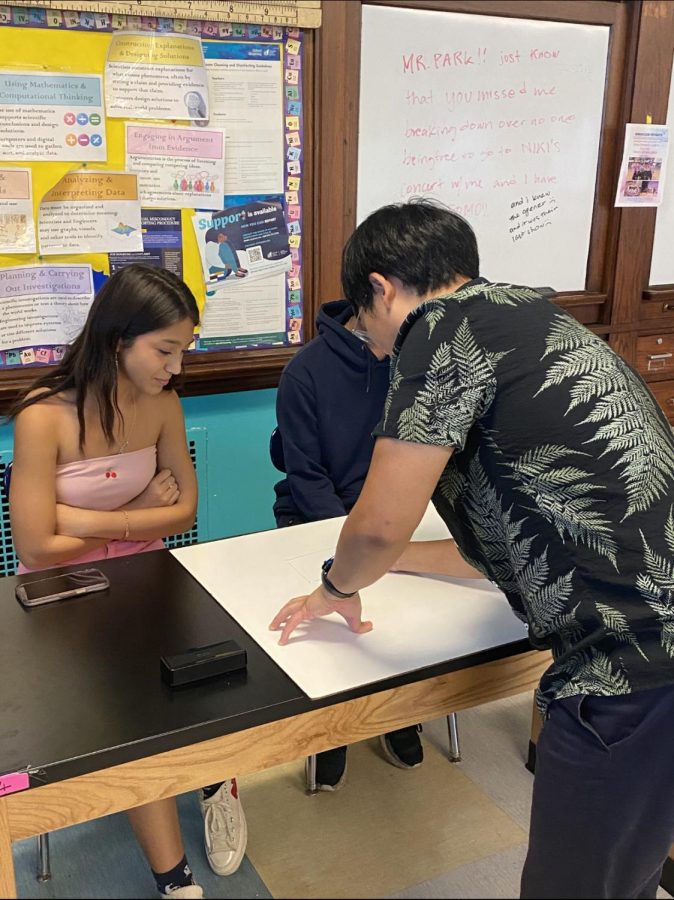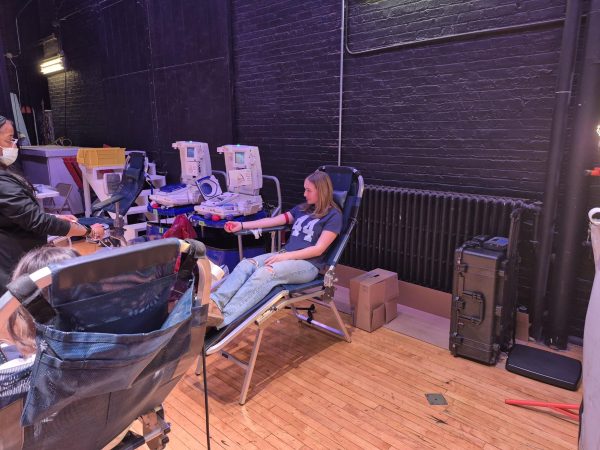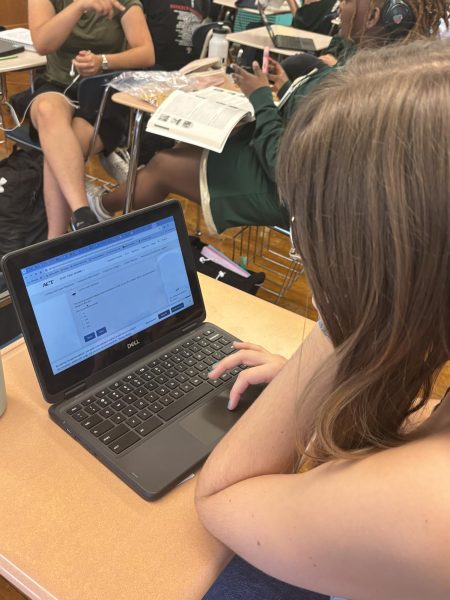A new way to grade: Lane teachers introduce standards based grading
Josh Park assisting physics student Naomi Verdi.
Some Lane students, including those in physics, Contemporary Painting and some English and computer science classes, have seen a recent restructuring in the way their work is graded.
Katharine Gomez, Lane’s grading and assessment director, said in an email to The Champion that she feels standards based grading helps teachers to understand specifically where students are struggling.
“The goal of SBG [standards based grading] is to ensure that students are growing and to be able to explicitly track that growth, while also ensuring that the grades and scores students earn reflect what they really know,” Gomez said.
Honors physics teacher Josh Park is one of the teachers who is now using the new system of grading, after the physics department elected to make the switch to standards based grading this past summer.
“Standards based grading is moving away from the traditional total points scale where every test is worth different than an exam, which is worth different than a homework assignment, based on point value,” Park said. “Every assignment has a set of standards that are assessed throughout the entire year, and then those standards are based on a scale of one to four.”
Contemporary Painting teacher Sarah Wain has chosen to use standards based grading for around a year, hoping that it can more accurately represent her students’ performance.
“Standards based grading is meant to tell students their level of mastery on particular learning standards,” Wain said. “Assignments are cumulative evidence toward the mastery of each standard. It is not an average grade of all assignments in a semester.”
Though the goal of standards based grading is to make the process of assessing students more fair and thorough, junior physics student Joe Tiberia said that his experience with standards based grading in physics has been troublesome so far.
“I do not understand it at all, because I feel like I’m exceeding in some things and then I get a two, and I feel like it’s a little unfair because they don’t tell you what you miss on,” Tiberia said.
Park, who has been using standards based grading since the beginning of this school year, said that the new system has been a challenge as well.
“I understand why we’re doing it. But the application of everything has been overwhelming, for me at least,” Park said.
Park also noted that the format of his physics class has changed significantly.
“There’s kind of no such thing as an exam anymore, or high stakes testing, because we’re just creating everything to a standard,” Park said. “So exams don’t have more weight than any other assignment.”
Translating grades from the one to four scale into the traditional A-F scale in Aspen has also been difficult, Park said.
“Standards based grading is supposed to be based on the whole concept of growth, so it should be a pass/fail rather than converting it back to a traditional scale. So if you tell the kids it’s going to go back to a 70, 80, 90 scale, all they care about is that 70, 80, 90 scale. They don’t care about the growth,” Park said.
Wain has also experienced some hiccups in the process while trying to find a way to input the newly formatted grades into Aspen.
“I haven’t figured out an easy way for students to see what I see, which would help them see all the evidence that gives them their actual grade on that standard,” Wain said.
Despite difficulties with inputting grades, Wain says that standards based grading is a good fit for her curriculum.
“It makes a lot of sense to me that we can kind of look at how a student does on a particular standard over a period of time, and grade them for their mastery of that particular skill, as opposed to just giving them an average grade at the end,” she said.
Wain added that her curriculum has broadened because of standards based grading.
“I’ve included way more artist statements and analyzed artists’ work for my students. So there’s a bit more reading and writing in the class, in addition to just making art,” she said.
Park said his students are adapting well to standards based grading despite some initial hesitation.
“I think some of them are a little bit shocked to see how they’re doing. And they’re a little bit nervous to see how the new grading system is going to affect them. But honestly, a lot of kids are just ‘whatever’ about it,” Park said.
Junior Carlos Orochera, one of Park’s physics students, has had a positive experience with standards based grading.
“I believe it’s a less hard grading system and it’s more realistic in evaluating students’ performance in school,” Orochera said.
Though Orochera likes the concepts of standards based grading, he still finds the specifics of what a student needs to do to achieve a three or four somewhat confusing.
Tiberia said he hopes that with more detailed feedback, standards based grading can become more straightforward for students.
“I think if they were to do it properly, you would have to specifically tell students how they would get a four, because you can’t just give them a three and not say why,” Tiberia said.
Park said that despite complications now, standards based grading at Lane has potential.
“It may be really hard, but it’s possible,” Park said. “I like standards based grading for what it is — it could potentially be awesome.”
Your donations directly fund the Lane Tech student journalism program—covering essential costs like website hosting and technology not supported by our school or district. Your generosity empowers our student reporters to investigate, write, and publish impactful stories that matter to our school community.
This website is more than a publishing platform—it's an archive, a research tool, and a source of truth. Every dollar helps us preserve and grow this resource so future students can learn from and build on the work being done today.
Thank you for supporting the next generation of journalists at Lane Tech College Prep!

Charlotte Price is a junior at Lane Tech and this is her first year writing for the Champion. She dances at Dance and Music Academy in a pre-professional...







